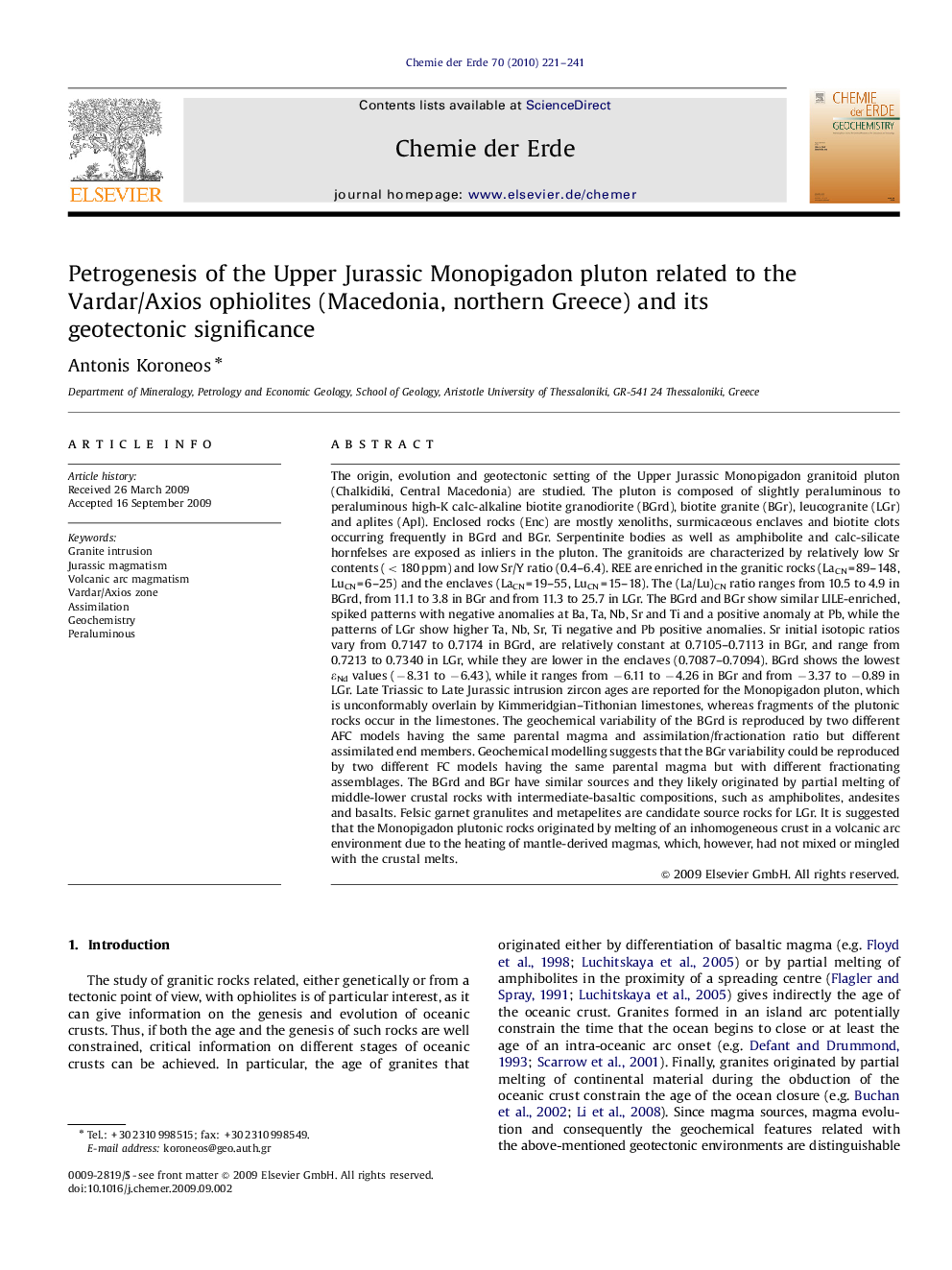| کد مقاله | کد نشریه | سال انتشار | مقاله انگلیسی | نسخه تمام متن |
|---|---|---|---|---|
| 4407067 | 1307344 | 2010 | 21 صفحه PDF | دانلود رایگان |
عنوان انگلیسی مقاله ISI
Petrogenesis of the Upper Jurassic Monopigadon pluton related to the Vardar/Axios ophiolites (Macedonia, northern Greece) and its geotectonic significance
دانلود مقاله + سفارش ترجمه
دانلود مقاله ISI انگلیسی
رایگان برای ایرانیان
کلمات کلیدی
موضوعات مرتبط
مهندسی و علوم پایه
علوم زمین و سیارات
ژئوشیمی و پترولوژی
پیش نمایش صفحه اول مقاله

چکیده انگلیسی
The origin, evolution and geotectonic setting of the Upper Jurassic Monopigadon granitoid pluton (Chalkidiki, Central Macedonia) are studied. The pluton is composed of slightly peraluminous to peraluminous high-K calc-alkaline biotite granodiorite (BGrd), biotite granite (BGr), leucogranite (LGr) and aplites (Apl). Enclosed rocks (Enc) are mostly xenoliths, surmicaceous enclaves and biotite clots occurring frequently in BGrd and BGr. Serpentinite bodies as well as amphibolite and calc-silicate hornfelses are exposed as inliers in the pluton. The granitoids are characterized by relatively low Sr contents (<180 ppm) and low Sr/Y ratio (0.4-6.4). REE are enriched in the granitic rocks (LaCN=89-148, LuCN=6-25) and the enclaves (LaCN=19-55, LuCN=15-18). The (La/Lu)CN ratio ranges from 10.5 to 4.9 in BGrd, from 11.1 to 3.8 in BGr and from 11.3 to 25.7 in LGr. The BGrd and BGr show similar LILE-enriched, spiked patterns with negative anomalies at Ba, Ta, Nb, Sr and Ti and a positive anomaly at Pb, while the patterns of LGr show higher Ta, Nb, Sr, Ti negative and Pb positive anomalies. Sr initial isotopic ratios vary from 0.7147 to 0.7174 in BGrd, are relatively constant at 0.7105-0.7113 in BGr, and range from 0.7213 to 0.7340 in LGr, while they are lower in the enclaves (0.7087-0.7094). BGrd shows the lowest εNd values (â8.31 to â6.43), while it ranges from â6.11 to â4.26 in BGr and from â3.37 to â0.89 in LGr. Late Triassic to Late Jurassic intrusion zircon ages are reported for the Monopigadon pluton, which is unconformably overlain by Kimmeridgian-Tithonian limestones, whereas fragments of the plutonic rocks occur in the limestones. The geochemical variability of the BGrd is reproduced by two different AFC models having the same parental magma and assimilation/fractionation ratio but different assimilated end members. Geochemical modelling suggests that the BGr variability could be reproduced by two different FC models having the same parental magma but with different fractionating assemblages. The BGrd and BGr have similar sources and they likely originated by partial melting of middle-lower crustal rocks with intermediate-basaltic compositions, such as amphibolites, andesites and basalts. Felsic garnet granulites and metapelites are candidate source rocks for LGr. It is suggested that the Monopigadon plutonic rocks originated by melting of an inhomogeneous crust in a volcanic arc environment due to the heating of mantle-derived magmas, which, however, had not mixed or mingled with the crustal melts.
ناشر
Database: Elsevier - ScienceDirect (ساینس دایرکت)
Journal: Chemie der Erde - Geochemistry - Volume 70, Issue 3, 2010, Pages 221-241
Journal: Chemie der Erde - Geochemistry - Volume 70, Issue 3, 2010, Pages 221-241
نویسندگان
Antonis Koroneos,